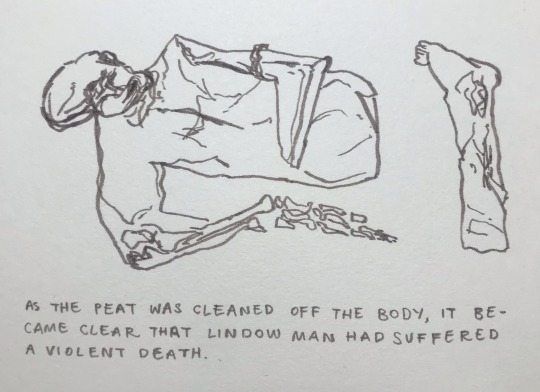#bog bodies
Text
The ethics of displaying human remains as museum objects
I'm writing an article for school about the ethics of displaying human bodies as museum objects and part of my thesis is looking into what the public thinks about human remains being displayed at museums.
With that, I want to know what that opinion is. So I was hoping that you would answer this poll for me. If I get enough votes, I'm going to use the results in my article, so i hope you'll be willing to answer and reblog to spread it!
I know the answers arent super nuanced, but i want the results to be somewhat easy to navigate, as it'll make it easier for me to use in my article.
No answer is wrong! This isn't a test of morality or a judgement on what you think, this is just an attempt to sus out what the overall opinion on this topic is.
#tagamemnon#egypt#ancient greece#bog bodies#mummies#history#museums#Had to redo the poll bc i forgot to add a 'no opinion' option OMG
990 notes
·
View notes
Text

here’s the ötzi illustrations i did for an infographic group project last year- my collaborator was @/kalinahansonart (on ig), who did the tattoos, map, and all of the texture and design assets. i was in charge of his body in life, his corpse, his belongings, and his portrait.
295 notes
·
View notes
Text

@blatterpussbunnyfromhell
What are bog bodies? They are corpses that are naturally mummified because they are buried in a peat bog. They tend to be found in Northern Europe.
A saga in three acts:
“We came to the chapel. I have passed it really in my walks, twice or thrice; it lies in a hollow, between two hills: an elevated hollow, near a swamp, whose peaty moisture is said to answer all the purposes of embalming on the few corpses deposited there.”
(Chapter 3)
“The place of Catherine’s interment, to the surprise of the villagers, was neither in the chapel under the carved monument of the Lintons, nor yet by the tombs of her own relations, outside. It was dug on a green slope in a corner of the kirk-yard, where the wall is so low that heath and bilberry-plants have climbed over it from the moor; and peat-mould almost buries it.”
(Chapter 16)
“I’ll tell you what I did yesterday! I got the sexton, who was digging Linton’s grave, to remove the earth off her coffin lid, and I opened it. I thought, once, I would have stayed there: when I saw her face again—it is hers yet!—he had hard work to stir me; but he said it would change if the air blew on it, and so I struck one side of the coffin loose, and covered it up: not Linton’s side, damn him! I wish he’d been soldered in lead.”
(Chapter 29)
39 notes
·
View notes
Text

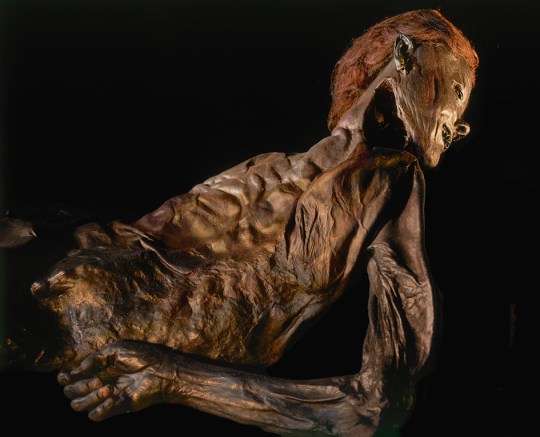

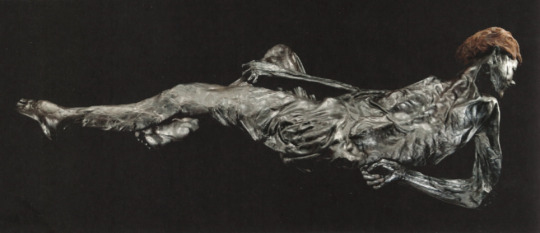
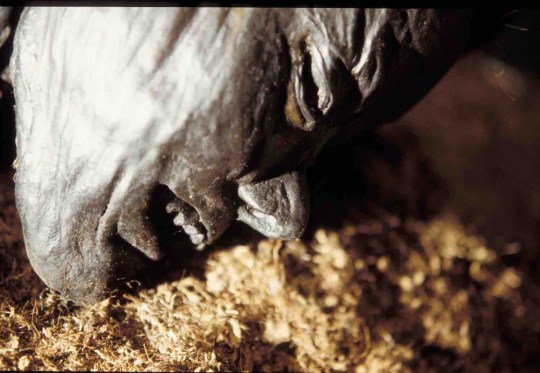


~ Grauballe Man.
Culture/Period: Iron Age
Place of discovery: Nebelgaard Bog
Place of origin: Denmark
From the source: He was violently killed and placed in a watery grave in a small bog. Here he lay for thousands of years until his discovery in April 1952.
#ancient#history#museum#human#human remains#archaeology#Grauballe Man#iron age#bog#bog bodies#human sacrifice#prehistory#prehistoric
452 notes
·
View notes
Note
BOOP
Hello anon! Thank you for the boop :)
Did you know that in ancient times that bogs were often used as a burial place for the dead? They have amazing preservation of the bodies that were buried in the peat and a lot of very interesting things have been learned and discovered about the peoples who lived in these places because of it
Just don’t ever look at the pictures of the bog bodies anon. Don’t do it. It’s not worth it.
#asks#anon#I gave myself the weirdest nightmare like dreams after that#don’t do it#bog bodies#tw burials
21 notes
·
View notes
Text
Imagine stumbling upon a well-preserved body in a bog! That's what happened last October when police were alerted to human bones in Northern Ireland's peatland. Now, detectives, forensic experts, and anthropologists have joined forces to unravel the truth behind this naturally preserved corpse from over 2,000 years ago, at the intriguing intersection of crime investigation and archaeology!
Employing the highest standards in forensic recovery of human remains, experts meticulously interpreted the findings of the Irish Bog body found among fossilized trees in Northern Ireland.
Adding to the mystery of this eerie discovery, archaeologists are actively exploring potential links between bog bodies and ancient rituals. Could this body be connected to ancient royal sacrifices?
#Bog Bodies#bog#human remains#DNA#forensics#Ireland#Irish#radio carbon dating#ancient#history#ancient origins
14 notes
·
View notes
Text
anyway, three weeks ago i read the following passage and i haven't been the same since

i've now read four (4) primary sources about ye olde titsucking and unfortunately will not shut up about it
6 notes
·
View notes
Text
Mediterranean writers were keen to emphasise that the Celts practiced human sacrifice, something Romans found particularly abhorrent, and suggested that Celtic priests consulted human entrails for messages from the gods. Were it not for the archaeological evidence recovered from the bogs of northwestern Europe, we could explain all this as negative propaganda, examples of the Romans demonising their enemy. However, a variety of prehistoric bodies that have been dredged from the wetlands of Ireland, Denmark and southern Scandinavia have shown that human sacrifice was indeed carried out at times; the broad similarity of injuries recorded suggest that these executions were all part of the same ritual practice.
Comparison of these so-called ‘bog bodies’ has indicated a form of execution which is sometimes referred to as the threefold death. A good example from Britain is that of a young man found preserved in Lindow Moss in Cheshire. Here, the individual had, at some point in the first century AD, been struck violently across the head, before being strangled with a tightly wound cord and having his throat cut. Finally, his lifeless body was deposited face down in the bog.
— The Celts: Who Were They, Where Did They Live, & What Happened After The Romans Left Britain?
#miles russell#the celts: who were they where did they live & what happened after the romans left britain?#history#classics#religion#celtic mythology#archaeology#celts#celtic britons#britain#england#human sacrifice#bog bodies#lindow man#threefold death
41 notes
·
View notes
Text
long shot, but does anyone have a link to that academic article that compared the circumstances of bog bodies in northern and western europe?
14 notes
·
View notes
Text

18 notes
·
View notes
Text
2023 Reading Log pt. 4
March was hard for me, both in terms of my personal life and in terms of my reading. I started a whole bunch of books that I haven't finished. Some of them I intend to come back to (two monster books, one for RPGs and one reference book). The ones I intentionally gave up on are listed here, as well as the whys of why I gave up on them.

16. Bestiarium Greenlandica, edited by Maria Bach Kreutzmann. Recommended to me a while ago by @abominationimperatrixx, but I have only been able to get a copy recently. This is the second edition, put out by Eye of Newt Press, which seems to specialize in publishing monster books with previously limited print runs (they also have an edition of Welsh Monsters and Mythical Beasts by C G J Ellis, for example). This book is an A-Z look at mythical creatures from Greenland, which entails a peek at traditional Thule culture. Anggakutt (the equivalent of shamans) use various monstrous spirits to guide them through the spiritual realm and work wonders for them, and these have to be negotiated with or even battled in order to recruit them. So there’s plenty of monsters, many of which are very obscure in English language sources, or confused with other creatures from other Inuit cultures. The book has illustrations for most of the monsters, some line drawings and some full color paintings. All of the art is great, and it doesn’t shy away from the sex and violence in the myths. So a trigger warning is at play if dead and decaying fetus monsters, ghouls with giant penises, or all manner of grotesque facial features are not your thing. But if you’re okay with those, this book is highly recommended.

17. Bog Bodies Uncovered by Miranda Aldhouse-Green. This book looks at the various bodies that have been discovered in peat bogs throughout northern Europe, and is primarily concerned with why these people were killed and placed in the bog. After a discussion of the history of finding bog bodies, and about the nature of bogs and how the tannins contribute to preservation, the book is primarily a forensic investigation. Its ultimate thesis is that most of the bog bodies represent intentional human sacrifices by Celtic and Germanic people. The author does a good job of supporting that claim, although her extrapolations and speculations go a little far for my taste (especially when she conjectures that the Lindow Man was sacrificed because of a specific battle written about by the Romans). The book features a mix of black and white photos and illustrations with color plates, which is always appreciated for a book about physical artifacts.

17a. Bad Gays: A Homosexual History by Huw Lemmey and Ben Miller. I gave up on this one around the halfway point—much longer than I typically go into a book I decide not to finish. That’s because I really wanted to like this one, but couldn’t. The subject is how queer history has often been sanitized and gay historical figures made saintly, when in reality there were plenty of unremarkable and some downright evil gay people as well. The book also wants to aim a giant fuck you at respectability politics, arguing for radical queer liberation and that the current state of gay representation is rooted in capitalism and patriarchy. It also also wants to make snarky quips about gay kings and military leaders—this is a very distant priority. I agree with the book’s politics in the broad sense, and there’s just enough quips and history to have kept me interested this long, but the overall feel of the book is very preachy, and not actually that interested in the lives of the individual subjects. There are ways to make a book both stridently anti-capitalist and an entertaining read, and this one fails.

17b. How Far the Light Reaches by Sabrina Imbler. I stopped this one a few pages into the second chapter. I was looking for a book about marine life and fun facts, and this has that, but is interwoven with personal memoir and is much heavier on the memoir. The first chapter is about how goldfish are stunted in fishbowls, but can grow to enormous sizes in the wild and can act as an invasive species. And this is contrasted with the author feeling stifled by small town life and realizing that they’re queer upon growing up. That was fine, but the second chapter draws connections between how mother octopuses starve themselves watching over eggs, and the generational eating disorders that the author and their mother dealt with. My mood couldn’t handle that. Maybe I’ll come back to this book when I’m in a more secure mental place, but I didn’t feel like crying while reading again. Not for a while—I think my allotment is one sad book a year.

18. Pests: How Humans Create Animal Villains by Bethany Brookshire. This feels like a companion volume to Mary Roach’s Fuzz. Both books are about how humans behave when animals get in their way, but Fuzz deals more with the humans and Pests deals more with the animals. There’s lots of evolution and ecology material here, including very recent research, like the possible link between the evolution of house mice and the contents of their gut flora, and a modern look at how Australia’s ecosystems are reacting to and coping with the introduction of cane toads. This book is much more the balance of science to personal experience that I was looking for right now, and I had a good time with this one.

19. Ancient Sea Reptiles by Darren Naish. I’ve been looking forward to this book since it was first announced, so I’m happy to report that it’s as good as I was hoping. The book discusses Mesozoic marine reptiles (with some guest appearances from Permian taxa, like mesosaurs). First, it goes through the history of their discovery and some overview of their anatomy, physiology and evolutionary relationships. Then, it goes through the clades. Ichthyosaurs, plesiosaurs, mosasaurs, marine crocodiles and sea turtles get their own chapter, and all the other groups, from weird Triassic one-offs to sea snakes, are compiled into a single chapter. Naish is one of my favorite science writers, as he combines a phylogeny-centric approach for an appreciation of the novelties and weirdness of specific genera. I would love it if he wrote a similar book about another group for which books for educated laypeople are thin on the ground, like stem crocodiles or non-mammalian synapsids.

20. Effin’ Birds by Aaron Reynolds. This is the book form of a Twitter feed, which I appreciate from a historical perspective. The feed, and the book, have two main jokes. One, pictures of birds with profanity as captions. Two, faux descriptions of bird behavior and habitats that are jokes about common types of unpleasant people, or people who avoid unpleasant people. I got a few laughs out of it, but I’m glad that I got this book from a library and would not pay money for it. The funniest thing about this book to me is that that selfsame library put it with the books about bird biology and field guides, when there is zero informational content in this book, combined with the book itself making a joke about how you’d never find this book in a library.
#reading log#what are birds#twitter#marine reptiles#paleontology#cladistics#pests#invasive species#biology#marine biology#memoir#gay history#lgtbq history#european history#bog bodies#monster books#greenland#greenland folklore#inuit folklore
37 notes
·
View notes
Text
Thinking about bog bodies and how wild it would be if Button House was by a peat bog and Mike and Alison discovered Robin’s mummified body while digging around one day
26 notes
·
View notes
Text
Top 6 macaque coded lyrics
I’m my father’s stubborn daughter
And I am no gentle lover
Only crown I wear is loyalty
My man is a stagnant water
A mud-your-linen, cacklin’ bogland
And I’m forever stuck his bog body
-Bog Bodies by Rabitology
#lmk#lego monkie kid#lmk macaque#lmk six eared macaque#lmk liu er mihou#song lyrics#rabbitology#bog bodies#Listen to the song it’s so good
3 notes
·
View notes
Text
Mouse Mummies
Anoxic bogs are most often found in northwestern Europe. What makes these bogs special is their lack of oxygen- thus “anoxic-“ and their content of chemicals called tannins. When living creatures happen to fall into a bog, their tissue is preserved because tannins keep it static and all the little mites that cause decomposition can’t live without oxygen. (Bones, however, are often dissolved if the peat is too acidic.) Not only are bodies preserved, but clothing and trinkets as well. This is how big bodies are made! You might have heard of the Tollund Man or the Yde Girl, both famous examples of European mummies, from Denmark and the Netherlands respectively. These mummies can be preserved for thousands of years.
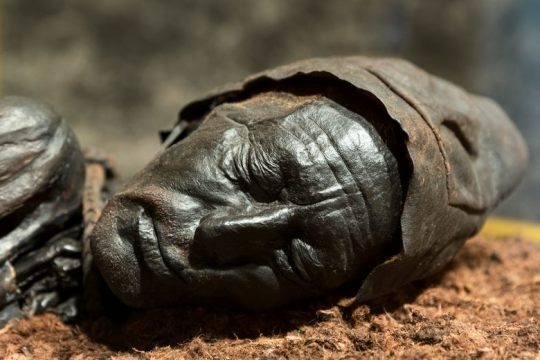
This is the Tollund Man, probably the most famous bog body
Now, marshes and bogs aren’t exactly the same thing, but for the prevalence of marshland in Mossflower country I’m sure that some of that could be a peat bog.
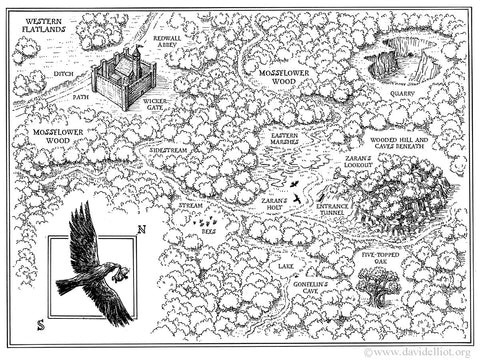
Slegg, Dirig, Gruntan Kurdly, the victims of the wytes… countless named and unnamed woodlanders have found themselves sinking in the swamp. Countless bodies under the surface.
I recently discussed in this post that “the 22 [Redwall] books cover hundreds and hundreds of seasons, their stories spreading farther than memory can reach.”
That is all to say, imagine what tales are hidden inside Mossflower wood. Imagine what relics of long-gone eras are preserved in the bodies of those who wandered through Mossflower and found themselves an unfortunate end. Imagine (accounting for the fact that not all muggy water is a bog) what the Maudie, Barbowla, and Log-a-Log Luglug were blissfully unaware of when running from the Brownrats. Just one of the thousands of stories Redwall has to tell.
#redwall#brian jacques#redwall theory#bog bodies#mummies#gruntan kurdly#eulalia!#mad Maudie the hon#doomwyte
82 notes
·
View notes
Photo

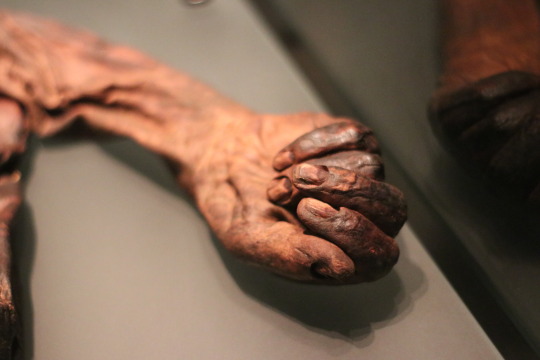
Bog bodies are so eerie and fascinating. I took these photos of Old Crogham man's hand in Dublin. He died between 2nd-4th c BC. Learn more in this film
33 notes
·
View notes
